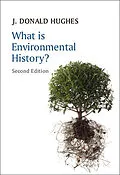In this new edition of his seminal student textbook, J. Donald Hughes provides a masterful overview of the thinkers, topics, and perspectives that have come to constitute the exciting discipline that is environmental history. He does so on a global scale, drawing together disparate trends from a rich variety of countries into a unified whole, illuminating trends and key themes in the process. Those already familiar with the discipline will find themselves invited to think about the subject in a new way. This new edition has been updated to reflect recent developments, trends, and new work in environmental history, as well as a brand new note on its possible future.
Students and scholars new to environmental history will find the book both an indispensable guide and a rich source of inspiration for future work.
J. DONALD HUGHES is John Evans Distinguished Professor of History at the University of Denver, Colorado.
Autorentext
J. DONALD HUGHES is John Evans Distinguished Professor of History at the University of Denver, Colorado.
Leseprobe
1
Defining Environmental History
Introduction
Environmental history studies the mutual relationships of humans and nature through time. Historians and others are active in this field in many parts of the world, the literature is vast and growing, and the subject is taught in schools and universities. Its audiences include students, other scholars, government and business policymakers, and a general public, all interested in environmental issues of great import in the modern world.
But what is environmental history? It is a kind of history that seeks understanding of human beings as they have lived, worked, and thought in relationship to the rest of nature through the changes brought by time. The human species is part of nature, but compared to most other species we have caused far-reaching alterations of the conditions of land, sea, air, and the other forms of life that share our tenure of the Earth. The changes humans have made in the environment have in turn affected our societies and our histories. Environmental historians tend to think that the unavoidable fact that human societies and individuals are interrelated with the environment in mutual change deserves constant recognition in the writing of history.
River in Himalayas, India, choked with erosional material resulting from deforestation in the headwaters. Photograph by author, 1994.
Speaking of the contribution that environmental history can make to other kinds of history, Donald Worster, a leading American environmental historian, said that it is "part of a revisionist effort to make the discipline far more inclusive in its narratives than it has traditionally been." 1 Historians should see human events within the context where they happen, and that is the entire natural environment. The narrative of history must, as the American historian William Cronon said, "make ecological sense." 2 The theme of the interaction of human events and ecological processes has been operative during every chronological period from the origin of humankind to the present.
The environmental problems that received world attention during the last 40 years of the twentieth century, and whose importance has only increased in the present century, show the need for environmental histories that will help in understanding ways that humans have in part caused them, reacted to them, and attempted to deal with them. A contribution of environmental history has been to turn the attention of historians to topical environmental issues that produce global changes, such as global warming, altering weather patterns, atmospheric pollution and damage to the ozone layer, the depletion of natural resources including forests and fossil fuels, the dangers of radiation spread by nuclear weapons testing and accidents at nuclear power facilities, worldwide deforestation, extinction of species and other threats to biodiversity, the introduction of opportunistic exotic species to ecosystems far from their regions of origin, waste disposal and other problems of the urban environment, pollution of rivers and oceans, the disappearance of wilderness and the loss of amenities such as natural beauty and access to recreation, and the environmental effects of warfare including weapons and agents intended to impact the resources and environments of antagonists. Although long enough to suggest the variety and seriousness of the changes that make up the contemporary environmental crisis, the foregoing list is, unfortunately, incomplete. It might seem that many of these problems have appeared only recently, but there is no doubt about their tremendous effect during the twentieth century, and most of them had antecedents in all the previous historical periods. Environmental historians have given attention to these contemporary problems, but they also realize that a relationship between humans and the environment has had a formative
Inhalt
1. Defining Environmental History
Introduction
The Themes of Environmental History
Among the Scholarly Disciplines
Environmental History and the Older History
2. Forerunners of Environmental History
Introduction
The Ancient World
Medieval and Early Modern Environmental Thought
The Early Twentieth Century
3. The Emergence of Environmental History in the United States
Introduction
American History from Conservation to Environment
Strands of Environmental History in the United States
Collaborators with Environmental History
4. Local, Regional, and National Environmental Histories
Introduction
Canada
Europe
The Mediterranean
The Middle East and North Africa
India, South and Southeast Asia
East Asia
Australia, New Zealand, and the Pacific Islands
Africa
Latin America
The Ancient World and the Middle Ages
Conclusion
5. Global Environmental History
Introduction
Books on World Environmental History
Topics of Global Importance
Environmental Movements
World History Texts
Conclusion
6. Issues and Directions in Environmental History
Introduction
Professionalism
Advocacy
Environmental Determinism
Presentism
Declensionist Narratives
Political-Economic Theory
The Next Issues
Conclusion
7. Thoughts on Doing Environmental History
Introduction
Guidance on Methodology
The Search for Sources
Resources
Conclusion: The Future of Environmental History
Notes
Select Bibliography
Index
